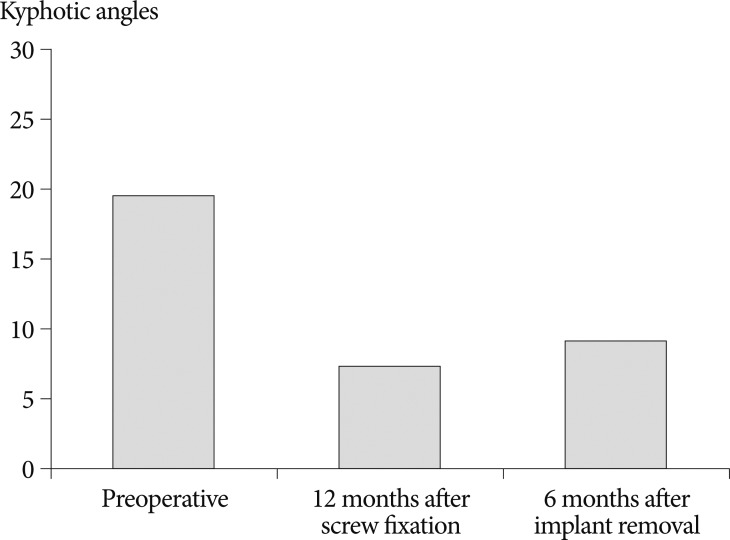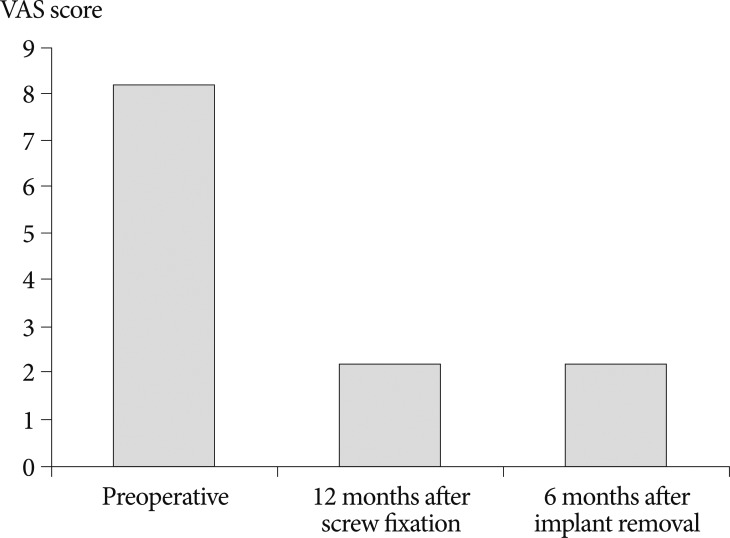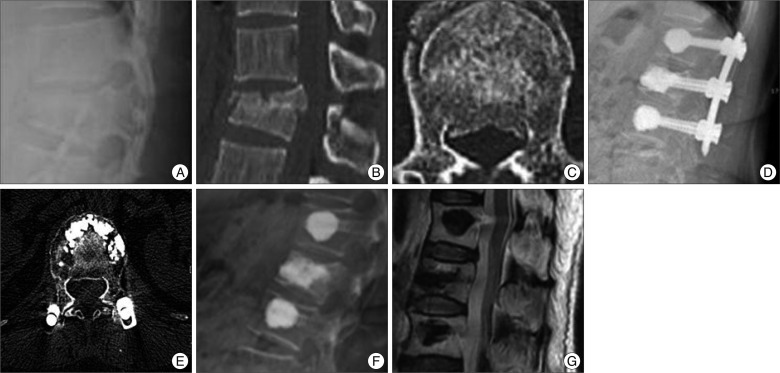J Korean Neurosurg Soc.
2012 Oct;52(4):353-358. 10.3340/jkns.2012.52.4.353.
Bone Cement-Augmented Short Segment Fixation with Percutaneous Screws for Thoracolumbar Burst Fractures Accompanied by Severe Osteoporosis
- Affiliations
-
- 1Department of Neurosurgery, School of Medicine, Chosun University, Gwangju, Korea.
- 2Department of Rehabilitation, Wonju College of Medicine, Yonsei University, Wonju, Korea.
- 3Department of Neurosurgery, Heori Sarang Hospital, Daejeon, Korea. chosunns@chosun.ac.kr
- KMID: 2190652
- DOI: http://doi.org/10.3340/jkns.2012.52.4.353
Abstract
OBJECTIVE
The purpose of this study was to determine the efficacy of bone cement-augmented short segment fixation using percutaneous screws for thoracolumbar burst fractures in a background of severe osteoporosis.
METHODS
Sixteen patients with a single-level thoracolumbar burst fracture (T11-L2) accompanying severe osteoporosis treated from January 2008 to November 2009 were prospectively analyzed. Surgical procedures included postural reduction for 3 days and bone cement augmented percutaneous screw fixation at the fracture level and at adjacent levels without bone fusion. Due to the possibility of implant failure, patients underwent implant removal 12 months after screw fixation. Imaging and clinical findings, including involved vertebral levels, local kyphosis, canal encroachment, and complications were analyzed.
RESULTS
Prior to surgery, mean pain score (visual analogue scale) was 8.2 and this decreased to a mean of 2.2 at 12 months after screw fixation. None of the patients complained of pain worsening during the 6 months following implant removal. The percentage of canal compromise at the fractured level improved from a mean of 41.0% to 18.4% at 12 months after surgery. Mean kyphotic angle was improved significantly from 19.8degrees before surgery to 7.8 at 12 months after screw fixation. Canal compromise and kyphotic angle improvements were maintained at 6 months after implant removal. No significant neurological deterioration or complications occurred after screw removal in any patient.
CONCLUSION
Bone cement augmented short segment fixation using a percutaneous system can be an alternative to the traditional open technique for the management of selected thoracolumbar burst fractures accompanied by severe osteoporosis.
Keyword
Figure
Cited by 2 articles
-
Implant Removal after Percutaneous Short Segment Fixation for Thoracolumbar Burst Fracture : Does It Preserve Motion?
Hyeun Sung Kim, Seok Won Kim, Chang Il Ju, Hui Sun Wang, Sung Myung Lee, Dong Min Kim
J Korean Neurosurg Soc. 2014;55(2):73-77. doi: 10.3340/jkns.2014.55.2.73.Posterior Screw Fixation in Previously Augmented Vertebrae with Bone Cement: Is It Inapplicable?
Jae Hoo Park, Chang Il Ju, Seok Won Kim
J Korean Neurosurg Soc. 2018;61(1):114-119. doi: 10.3340/jkns.2017.0202.004.
Reference
-
1. Acosta FL Jr, Aryan HE, Taylor WR, Ames CP. Kyphoplasty-augmented short-segment pedicle screw fixation of traumatic lumbar burst fractures : initial clinical experience and literature review. Neurosurg Focus. 2005; 18:e9. PMID: 15771399.2. Arrington ED, Smith WJ, Chambers HG, Bucknell AL, Davino NA. Complications of iliac crest bone graft harvesting. Clin Orthop Relat Res. 1996; 300–309. PMID: 8769465.
Article3. Cho DY, Lee WY, Sheu PC. Treatment of thoracolumbar burst fractures with polymethyl methacrylate vertebroplasty and short-segment pedicle screw fixation. Neurosurgery. 2003; 53:1354–1360. discussion 1360-1361. PMID: 14633301.
Article4. de Klerk LW, Fontijne WP, Stijnen T, Braakman R, Tanghe HL, van Linge B. Spontaneous remodeling of the spinal canal after conservative management of thoracolumbar burst fractures. Spine (Phila Pa 1976). 1998; 23:1057–1060. PMID: 9589546.
Article5. Denis F. The three column spine and its significance in the classification of acute thoracolumbar spinal injuries. Spine (Phila Pa 1976). 1983; 8:817–831. PMID: 6670016.
Article6. Gahr RH, Strasser S, Strasser E, Schmidt OI. Percutaneous internal fixation of thoracolumbar spine fractures. Top Spinal Cord Inj Rehabil. 2006; 12:45–54.
Article7. Hakalo J, Wroński J. [Complications of a transpedicular stabilization of thoraco-lumbar burst fractures]. Neurol Neurochir Pol. 2006; 40:134–139. PMID: 16628510.8. Huang QS, Chi YL, Wang XY, Mao FM, Lin Y, Ni WF, et al. [Comparative percutaneous with open pedicle screw fixation in the treatment of thoracolumbar burst fractures without neurological deficit]. Zhonghua Wai Ke Za Zhi. 2008; 46:112–114. PMID: 18509968.9. Kaneda K, Taneichi H, Abumi K, Hashimoto T, Satoh S, Fujiya M. Anterior decompression and stabilization with the Kaneda device for thoracolumbar burst fractures associated with neurological deficits. J Bone Joint Surg Am. 1997; 79:69–83. PMID: 9010188.
Article10. Lee YS, Sung JK. Long-term follow-up results of short-segment posterior screw fixation for thoracolumbar burst fractures. J Korean Neurosurg Soc. 2005; 37:416–421.11. Lü FX, Huang Y, Zhang Q, Shi FL, Zhao DS, Hu Q. Pedicle screw fixation against burst fracture of thoracolumbar vertebrae. Chin J Traumatol. 2007; 10:349–352. PMID: 18045516.12. Mahar A, Kim C, Wedemeyer M, Mitsunaga L, Odell T, Johnson B, et al. Short-segment fixation of lumbar burst fractures using pedicle fixation at the level of the fracture. Spine (Phila Pa 1976). 2007; 32:1503–1507. PMID: 17572619.
Article13. Parker JW, Lane JR, Karaikovic EE, Gaines RW. Successful short-segment instrumentation and fusion for thoracolumbar spine fractures : a consecutive 41/2-year series. Spine (Phila Pa 1976). 2000; 25:1157–1170. PMID: 10788862.
Article14. Scapinelli R, Candiotto S. Spontaneous remodeling of the spinal canal after burst fractures of the low thoracic and lumbar region. J Spinal Disord. 1995; 8:486–493. PMID: 8605423.
Article15. Sihvonen T, Herno A, Paljärvi L, Airaksinen O, Partanen J, Tapaninaho A. Local denervation atrophy of paraspinal muscles in postoperative failed back syndrome. Spine (Phila Pa 1976). 1993; 18:575–581. PMID: 8484148.
Article16. Son BG, Bae KJ, Jung ES, Choi ES, Shin JH, Kim MJ, et al. Results of posterior short segment fixation cases which are more than 65% canal compromise of thoracolumbar burst fractures (Minimum 3 years follow-up). Korean J Spine. 2007; 4:199–204.17. Soshi S, Shiba R, Kondo H, Murota K. An experimental study on transpedicular screw fixation in relation to osteoporosis of the lumbar spine. Spine (Phila Pa 1976). 1991; 16:1335–1341. PMID: 1750009.
Article
- Full Text Links
- Actions
-
Cited
- CITED
-
- Close
- Share
- Similar articles
-
- Short Segment Fixation for Thoracolumbar Burst Fracture Accompanying Osteopenia : A Comparative Study
- Bone Cement-Augmented Percutaneous Short Segment Fixation: An Effective Treatment for Kummell's Disease?
- Short Segment versus Long Segment Pedicle Screws Fixation in Management of Thoracolumbar Burst Fractures: Meta-Analysis
- Bone Cement Augmentation of Short Segment Fixation for Unstable Burst Fracture in Severe Osteoporosis
- Long-term Follow-up Results of Short-segment Posterior Screw Fixation for Thoracolumbar Burst Fractures






